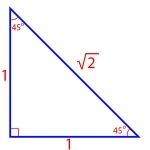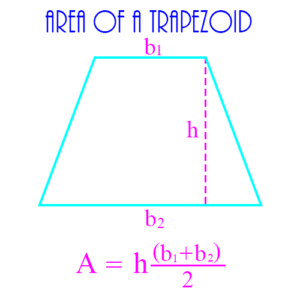Definitions
Often, the answer to a question is obvious if you just know the definition of some term in the question. So, it’s very important to know the definitions of all the terms in the questions! Here are some important definitions, given in alphabetical order.
Categories of Terms
Angles – Acute, Right, Obtuse, Vertical, Complementary, Supplementary
Circles – Center, Radius, Diameter, Circumference, Tangent, Secant
Coordinate Geometry – Coordinate Axes, Coordinates, Coordinate Plane, Quadrants, Point, Line, Slope, Intercept
Equations – Linear, Quadratic, Rational
Exponents – Positive, Negative, Fractional, Logarithm
Integer Operations – Prime Factorization, Least Common Multiple, Greatest Common Factor (Divisor), Factorial
Lines – Parallel, Perpendicular, Transversal, Tangent, Secant
Numbers – Natural, Integer, Rational, Fraction, Irrational, Real, Imaginary, Complex, Scientific Notation, Prime
Polynomials – Constant, Coefficient, Variable, Term, Monomial, Product, Factorization
Probability, Combinations, Permutations
Solid Geometry – Prism, Cube, Cylinder, Sphere, Cone, Pyramid
Square, Rectangle, Trapezoid, Parallelogram
Statistical Functions – Mean, Median, Mode
Triangles – Acute, Right, Pythagorean Theorem, Hypotenuse, Legs, Equilateral, Isosceles, Scalene, Obtuse, Similar, Congruent
Special Triangles – 30-60-90, 45-45-90
Trigonometric Functions – Sine, Cosine, Tangent, Secant, Cosecant, Cotangent, Inverse Functions
Individual Terms and Their Definitions
Acute Angle: An angle of less than 90 degrees.
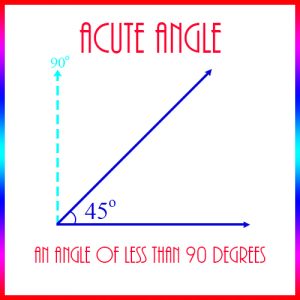
See also Right, Obtuse, Vertical, Complementary, Supplementary
Acute Triangle: A triangle having 3 acute angles.
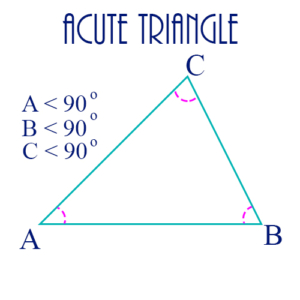
See also Right, Equilateral, Isosceles, Scalene, Obtuse, Similar, Congruent
Center of a Circle: The point in the middle of the circle that is equidistant from all the points on the circle.
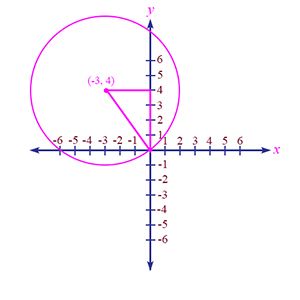
See also Radius, Diameter, Circumference, Tangent, Secant, Circles
Circle: A set of points equidistant from a given point. The given point is the center of the circle, and the distance from the center to any point on the circle is the radius.

See also Center, Radius, Diameter, Circumference, Tangent, Secant
Circumference of a Circle: The distance around (or the perimeter of) the circle.
Given by the formula:
\(\begin{align}C = \pi d\end{align}\)
where d is the diameter of the circle, and π is a constant value approximately equal to 3.14.
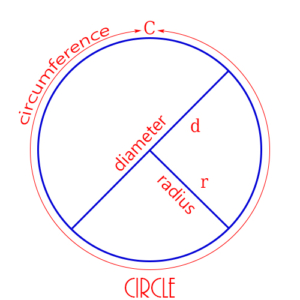
See also Center, Radius, Diameter, Tangent, Secant, Circles
Coefficient: The constant value in a term containing a variable. For example, 2x is a term, and 2 is the coefficient in this term. In the polynomial
\(\begin{align}3x^2 + 5x + 9\end{align}\)
3 is the coefficient of the first term, and 5 is the coefficient of the second term.
See also Constant, Variable, Term, Monomial, Product, Factorization
Combinations: The number of ways of grouping some set of things without regard to order. For example, there are 7 different combinations of the elements in the set {1, 2, 3}: {1}, {2}, {3}, {1, 2}, {1, 3}, {2, 3}, and {1, 2, 3}. There are 3 combinations of these elements if we take them just 2 at a time: {1, 2}, {1, 3}, {2, 3}.
See also Probability, Permutations
Complementary Angles: Two angles whose sum is 90 degrees.
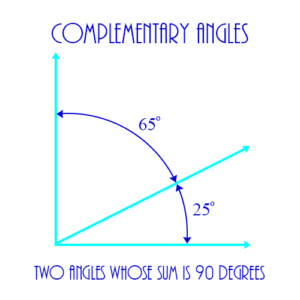
See also Acute, Right, Obtuse, Vertical, Supplementary Angles
Complex Number: A number consisting of a real number and an imaginary number. For example, 3 + 5i is a complex number whose real part is 3 and whose imaginary part is 5i.
See also Natural, Integer, Rational, Fraction, Irrational, Real, Imaginary
Cone: A 3-dimensional geometric figure whose base is a circle, and which moves up from the base until it converges to a single point. Its volume is calculated from the formula:
\(\begin{align}V = \frac{1}{3} \pi r^2 h\end{align}\)
where r is the radius of the circle at the base, and h is the height from the base to the point at the top.
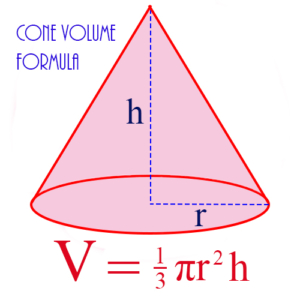
See also Prism, Cube, Cylinder, Sphere, Pyramid
Congruent Triangles: Two triangles which are exactly equal in their corresponding sides and angles.The figure below shows two congruent triangles, one on the left, the other on the right, created by dividing an equilateral triangle in half. Note the equality of corresponding parts: Each triangle has a side of length 1 and a side of length 2. The vertical line in the middle is a side common to both triangles. Also, the three angles of both triangles are equal to each other: Each triangle has an angle of size 60° and an angle of 30°. Finally, the angle the vertical line makes with the base of the triangle is a right angle for each triangle.
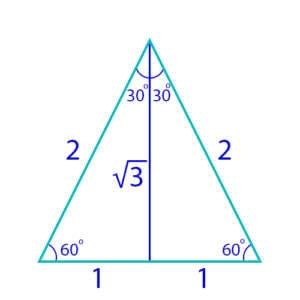
See also Acute, Right, Equilateral, Isosceles, Scalene, Obtuse, Similar
Constant: A fixed value, either a real, imaginary, or complex number. It may be a term in a polynomial. The coefficients in polynomial terms are constants. An unspecified constant is usually indicated by a letter from the beginning of the alphabet, like a, b, or c.
See also Coefficient, Variable, Term, Monomial, Product, Factorization
Coordinate Axes: The straight lines, one horizontal (the x-axis), and the other vertical (the y-axis), that define a plane (the Coordinate Plane) for graphing equations. Every real number is on each of these two axes, and the point at which the axes intersect is 0 on both axes. Moving to the right on the x-axis, the numbers increase, and moving to the left they decrease. Moving up on the y-axis numbers increase, and moving down they decrease. Every point on the coordinate plane has an x-coordinate and a y-coordinate, two real numbers which define exactly where the point is on the plane.
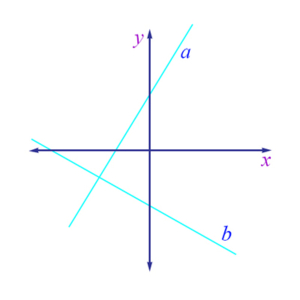
See also Coordinates, Quadrants, Point, Line, Slope, Intercept
Coordinate Plane: See Coordinate Axes
Coordinates: An ordered pair of real numbers (x, y) which identify a point on the coordinate plane. For example, the pair (-3, 4) identifies a point which is 3 units to the left on the x axis and 4 units up on the y axis.

See also Coordinate Axes, Quadrants, Point, Line, Slope, Intercept
Cosecant: A trigonometric function on angles. The cosecant’s value is the inverse of the sine’s, and so is given by the formula:
\(\begin{align}\csc A = \frac{h}{o}\end{align}\)
where angle A is in a right triangle, o is the side opposite A, and h is the hypotenuse of the triangle.
See also Sine, Cosine, Tangent, Secant, Cotangent, Inverse Functions
Cosine: A trigonometric function on angles. The cosine’s value is given by the formula:
\(\begin{align}\cos A = \frac{a}{h}\end{align}\)
where angle A is in a right triangle, a is the side adjacent to A, and h is the hypotenuse of the triangle.
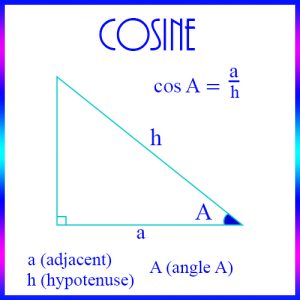
See also Sine, Tangent, Secant, Cosecant, Cotangent, Inverse Functions
Cotangent: A trigonometric function on angles. The cotangent’s value is the inverse of the tangent’s, and so is given by the formula:
\(\begin{align}\cot A = \frac{a}{o}\end{align}\)
where angle A is in a right triangle, o is the side opposite A, and a is the side adjacent to A.
See also Sine, Cosine, Tangent, Secant, Cosecant, Inverse Functions
Cube: A 3-dimensional figure of 6 sides, each of which is a square with the same dimensions. Its volume is given by the formula:
\(\begin{align}V = e^3\end{align}\)
where e is the length of each edge of the cube.
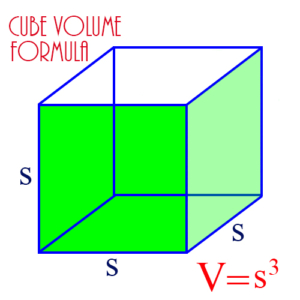
See also Prism, Cylinder, Sphere, Cone, Pyramid
Cylinder: A 3-dimensional figure whose base is a circle, and which continues straight up to height h until it ends in a circle of the same size as the base. Its volume is given by the formula:
\(\begin{align}V = \pi r^2 h\end{align}\)
where r is the radius of the base circle, and h is the height of the cylinder.
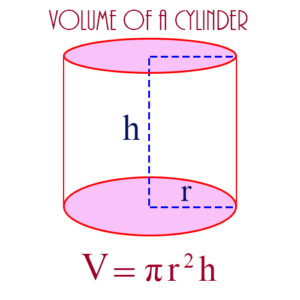
See also Prism, Cube, Sphere, Cone, Pyramid
Diameter of a Circle: Any line segment from one point on the circle to a point on the opposite side of the circle, passing through the center of the circle. Its length (also called “the diameter”) is always twice the length of a radius.

See also Radius, Circumference, Tangent, Secant, Circles
Equilateral Triangle: A triangle with 3 equal sides.
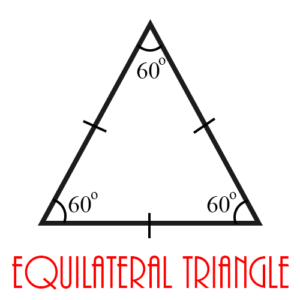
See also Acute, Right, Isosceles, Scalene, Obtuse, Similar, Congruent
Exponent: The power a number or variable is raised to in an expression. This power can be positive, negative, zero, and fractional. Indeed, the exponent can be any real number. If the exponent is 0, then the value reduces to 1; that is, \(\begin{align}x^0 = 1\end{align}\). Other examples:
- \(\begin{align}2^3 = 2 \times 2 \times 2 = 8\end{align}\)
- \(\begin{align}2^{-3} = \frac{1}{2^3} = \frac{1}{8}\end{align}\)
- \(\begin{align}2^\frac{1}{2} = \sqrt{2}\end{align}\)
See also Logarithm
Factorial: The operation of multiplying a positive integer by every positive integer less than or equal to it. For example, 4 factorial (written 4!) is
\(\begin{align}4 \times 3 \times 2 \times 1 = 24\end{align}\)
See also Prime Factorization, Least Common Multiple, Greatest Common Factor (Divisor)
Factorization of Polynomials: An expression which shows a polynomial as a product of two or more smaller polynomials. For example, the following is a factorization of a polynomial:
\(\begin{align}x^2 – 5x + 6 = (x -2)(x – 3)\end{align}\)
The expression on the right of the equals sign is a factorization of the expression on the left.
See also Constant, Coefficient, Variable, Term, Monomial, Product
Fraction: A number, also called a rational number, which is a ratio of two integers, consisting of a numerator and a denominator. 3/4 is a fraction with the numerator being 3 and the denominator being 4.
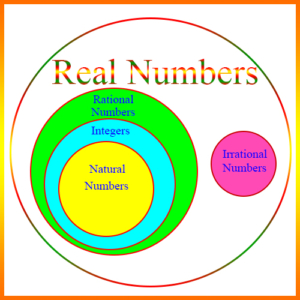
See also Natural, Integer, Rational, Irrational, Real, Imaginary, Complex
Greatest Common Factor (Divisor): The largest number which evenly divides two or more numbers. The greatest common factor (or the greatest common divisor) of 20 and 24, for example, is 4. Even though 2 evenly divides both numbers, it’s smaller than 4, so 4 is the greatest common factor.
See also Prime Factorization, Least Common Multiple, Factorial
Hypotenuse: The side of a right triangle opposite the right angle.
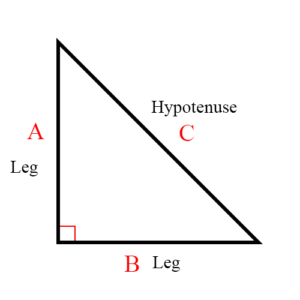
See also Right Triangle, Legs, Pythagorean Theorem
Imaginary Number: A number defined to be the square root of -1, called “i”, multiplied by some real number. Thus, 3i is an imaginary number.
See also Natural, Integer, Rational, Fraction, Irrational, Real, Complex
Integer: A whole number, which can be positive, negative, or zero. For example, 5, 17, -8, -365, and 0 are integers.

See also Natural, Rational, Fraction, Irrational, Real, Imaginary, Complex
Intercept: The point at which a line passes through the x- or the y-axis. For example, in the equation:
\(\begin{align}y = 3x + 12\end{align}\)
the line passes through the y-axis at y = 12, and through the x-axis as x = -4. Thus, the y-intercept is 12 and the x-intercept is -4.
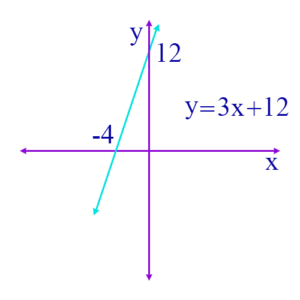
See also Coordinate Axes, Coordinates, Quadrants, Point, Line, Slope
Inverse Trigonometric Functions: Functions which associate with a given value the angle whose original function has that value. Example: If
\(\begin{align}\cos {60} = \frac{1}{2}\end{align}\)
then
\(\begin{align}\cos^{-1} \frac{1}{2} = {60}\end{align}\)
Read this as “the angle whose cosine is \(\begin{align}\frac{1}{2}\end{align}\) is \(\begin{align}60\end{align}\)”. So the inverse of cosine
\(\begin{align}\cos^{-1}\end{align}\)
takes the cosine value and gives the corresponding angle as a result. The other inverse trigonometric functions act in the corresponding way. Sometimes the inverse function is written (for example) \(\begin{align}\arccos\end{align}\) instead of \(\begin{align}\cos^{-1}\end{align}\).
See also Sine, Cosine, Tangent, Secant, Cosecant, Cotangent
Irrational Number: A number which is a real number, but is not a rational number. That is, it cannot be expressed as a ratio of two integers. \(\begin{align}\sqrt{2}\end{align}\) and π are irrational numbers.

See also Natural, Integer, Rational, Fraction, Real, Imaginary, Complex
Isosceles Triangle: A triangle with two equal sides. The two angles opposite the two equal sides will also be equal.
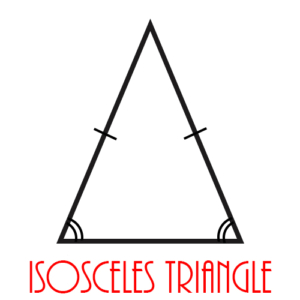
See also Acute, Right, Equilateral, Scalene, Obtuse, Similar, Congruent
Least Common Multiple: The smallest number which is a multiple of two or more numbers. For example, the least common multiple of 6 and 10 is 30, since even though 60 is a multiple of both numbers, 30 is also and is smaller than 60.
See also Prime Factorization, Greatest Common Factor (Divisor), Factorial
Legs of a Right Triangle: The two sides of the right triangle whose intersection forms the right angle.

See also Right Triangle, Hypotenuse, Pythagorean Theorem
Line: A set of points on the coordinate plane that is defined by a linear equation with x and y as variables. Every pair of (x, y) points that satisfies the equation is on the line, and every pair that does not satisfy the equation is not on the line. An example of such an equation is
\(\begin{align}y = 3x + 5\end{align}\)
This equation defines a straight line which passes through the y axis at y = 5.
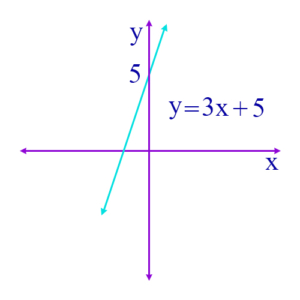
See also Coordinate Axes, Coordinates, Quadrants, Point, Slope, Intercept
Linear Equation: An equation with x, or x and y, as variables, but with every variable having an exponent of 1. Examples:
\(\begin{align}4x + 2 = 6\end{align}\)
\(\begin{align}5x – 3y = 17\end{align}\)
They are called “linear” because the graph of such an equation on the coordinate plane is a straight line.
See also Quadratic, Rational Equations
Logarithm: A fancy (and confusing) word for exponent. Actually, if you know how to read it from left to right, then it’s not so confusing. When a logarithm is written, at least two pieces of information are given: the “base”, and the derived value. An example:
\(\begin{align}\log_3 9 = 2\end{align}\)
Translated, this should be read from left to right as: “The exponent you give 3 to get a value of 9 is 2.” Or, in other words, \(\begin{align}3^2 = 9\end{align}\). In more general terms, “The exponent you give the base (3 in this example) to get the value (9 in this example) is \(\begin{align}\log_3 9\end{align}\). Since we know that \(\begin{align}3^2 = 9\end{align}\), then \(\begin{align}\log_3 9\end{align}\) is 2. More examples:
-
- \(\begin{align}\log_5 125 = 3\end{align}\) because \(\begin{align}5^3 = 125\end{align}\)
- \(\begin{align}\log_{25} 5 = \frac{1}{2}\end{align}\) because \(\begin{align}25^\frac{1}{2} = \sqrt{25} = 5\end{align}\)
- \(\begin{align}\log_4 \frac{1}{16} = -2\end{align}\) because \(\begin{align}4^{-2} = \frac{1}{4^2} = \frac{1}{16}\end{align}\).
See also Exponent
Mean: The computed average of a list of numbers. For example, the mean of a list of 3 numbers is calculated by adding the 3 numbers together and then dividing by 3.
See also Median, Mode
Median: The number whose value is in the middle of the values of a list of numbers. Example: In the list, 8, 15, 6, 9, 14, the median is 9, since its value is less than 14 and 15, and greater than 6 and 8.
Mode: The value in a list of values that occurs the most frequently. Thus, if we have a list, 3, 8, 8, 4, 7, then the mode is 8.
Monomial: A polynomial with only a single term. Example: \(\begin{align}3x^2\end{align}\)
See also Constant, Coefficient, Variable, Term, Product, Factorization
Natural Number: A positive integer, or “counting number.” 1, 2, 3, etc. are natural numbers. 0 is sometimes considered a natural number also.

See also Integer, Rational, Fraction, Irrational, Real, Imaginary, Complex
Obtuse Angle: An angle larger than 90 degrees but less than 180 degrees.
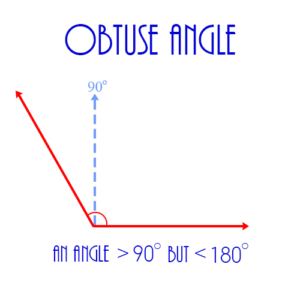
See also Acute, Right, Vertical, Complementary, Supplementary Angles
Obtuse Triangle: A triangle with one obtuse angle.
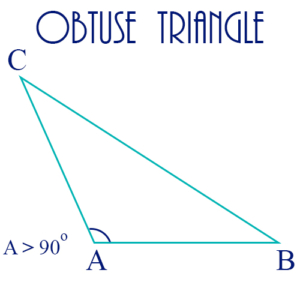
See also Acute, Right, Equilateral, Isosceles, Scalene, Similar, Congruent
Parallel Lines: Two lines which never intersect.
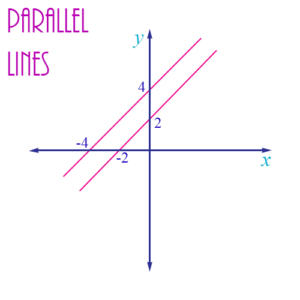
See also Perpendicular, Transversal, Tangent, Secant
Parallelogram: A 4-sided geometric figure in which opposite sides are parallel.
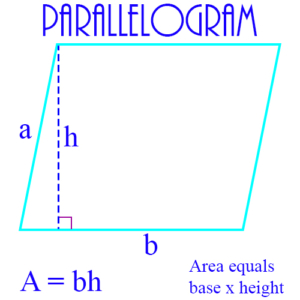
See also Square, Rectangle, Trapezoid
Permutations: The number of different ways of arranging a set of objects, where order is important. For example, {1, 2, 3} can be ordered in 6 different ways: 123, 132, 213, 231, 312, 321. The number of permutations of a set of n objects is n! (n factorial)
See also Probability, Combinations
Perpendicular Lines: Two lines which intersect at a right angle.
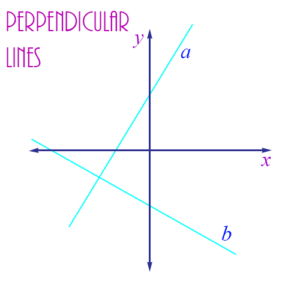
See also Parallel, Transversal, Tangent, Secant, Right Angle
Point on the Coordinate Plane: A place on the coordinate plane which is exactly identified by two real numbers, the x-coordinate and the y-coordinate of the point.
Examples:
-
-
-
-
- Point A (4, 3) is the point 4 units to the right on the x-axis, and 3 units up on the y-axis. It’s in the first quadrant.
- Point B (-4, 3) is the point 4 units to the left on the x-axis, and 3 units up on the y-axis. It’s in the second quadrant.
- Point C (-4, -3) is the point 4 units to the left on the x-axis, and 3 units down on the y-axis. It’s in the third quadrant.
- Point D (4, -3) is the point 4 units to the right on the x-axis, and 3 units down on the y-axis. It’s in the fourth quadrant.
-
-
-

See also Coordinate Axes, Coordinates, Quadrants, Line, Slope, Intercept
Prime Factorization: The representation of a positive integer as a product of powers of primes (a p-p-p!). For example, the prime factorization of 180 is
\(\begin{align}2^2 \times 3^2 \times 5\end{align}\)
since the only prime numbers that divide 180 are 2 (twice), 3 (twice), and 5.
See also Least Common Multiple, Greatest Common Factor (Divisor), Factorial, Prime
Prime Number: An integer greater than 1 which can only be evenly divided by itself or by 1. Examples: 2, 3, 5, 17, 43.
See also Prime Factorization
Prism: A 3-dimensional object, a polyhedron, with two parallel faces, called bases, which are identical in size and shape. The other faces are parallelograms.
See also Cube, Cylinder, Sphere, Cone, Pyramid
Probability: A number between 0 and 1 which represents the likelihood of a certain event’s happening. It’s typically measured as a fraction, with the number of possible outcomes of the event in the denominator, and the number of favorable events in the numerator. For example, if you randomly draw a card from a pack of 52 with 4 aces in it, the probability of drawing an ace is 4/52, or 1/13.
See also Combinations, Permutations
Product: The result of the multiplication of 2 or more terms in a polynomial, or two or more numbers otherwise. Example of a polynomial product:
\(\begin{align}(x + 2) (x – 4) = x^2 – 2x – 8\end{align}\)
See also Constant, Coefficient, Variable, Term, Monomial, Factorization
Pyramid: A 3-dimensional object, with a base which is usually a square, a rectangle, or an equilateral triangle, and each vertex of which is connected via a straight line to an apex. The figure shows a pyramid with a rectangular base, as well as the formula for calculating its volume.
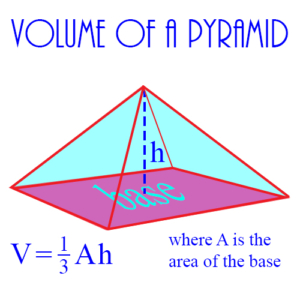
See also Prism, Cube, Cylinder, Sphere, Cone
Pythagorean Theorem: A statement that shows the relationship between the hypotenuse and the legs of a right triangle as a famous formula:
\(\begin{align}a^2 + b^2 = h^2\end{align}\)
where a and b are the lengths of the legs of the triangle, and h is the length of the hypotenuse.
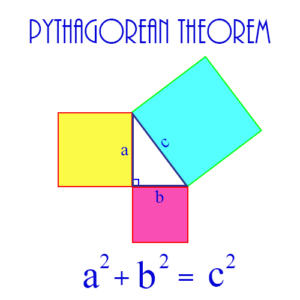
See also Acute, Right, Equilateral, Isosceles, Scalene, Obtuse, Similar, Congruent, Hypotenuse, Legs
Quadrants: The four sections of the coordinate plane – the first quadrant is the upper right, the second is the upper left, the third is the lower left, and the fourth is the lower right.
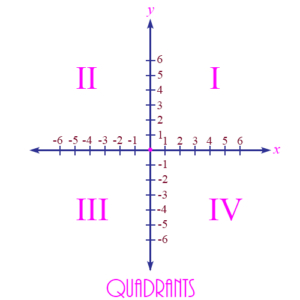
See also Coordinate Axes, Coordinates, Point, Line, Slope, Intercept
Quadratic Equation: An equation with x as a variable, and where the highest power of x is 2. Examples:
- \(\begin{align}x^2 + 4x – 5 = 0\end{align}\)
- \(\begin{align}3x^2 +2x – 15 = 0\end{align}\)
All quadratic equations can be solved using the quadratic formula:
\(\begin{align} x = \frac { – b \pm \sqrt {b^2 – 4ac} } {{2a}}\end{align}\)
where the original equation has the form:
\(\begin{align}ax^2 + bx + c = 0\end{align}\)
See also Linear, Rational Equations
Radius of a Circle: Any line segment from the center of the circle to a point on the circle. Its length (also called “the radius”) is always half the length of a diameter.
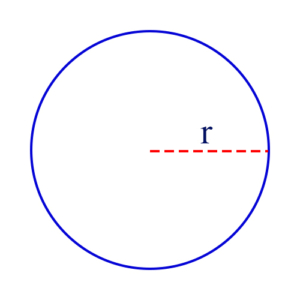
See also Diameter, Circumference, Tangent, Secant, Circles
Rational Equation: An equation where at least one of the terms is a fraction – typically where the variable is in the denominator. Example:
\(\begin{align}\frac{12}{x} = 3\end{align}\)
See also Linear, Quadratic Equations
Rational Number: A number which is a fraction or “ratio” between two integers. 2/5, 25/8, -4/3, and 0 are all rational numbers. Every integer is a rational number. Rational numbers are also considered real numbers.

See also Natural, Integer, Fraction, Irrational, Real, Imaginary, Complex
Real Number: A number which is either a rational or an irrational number. Notice this division of the two types of real numbers in the figure above.
See also Natural, Integer, Rational, Fraction, Irrational, Imaginary, Complex
Rectangle: A 4-sided geometric figure with each angle a right angle.
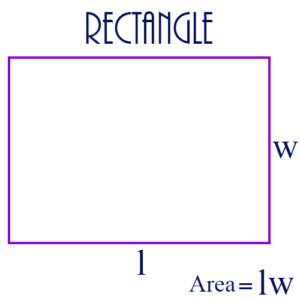
See also Square, Trapezoid, Right Angle, Parallelogram
Right Angle: An angle of 90 degrees.
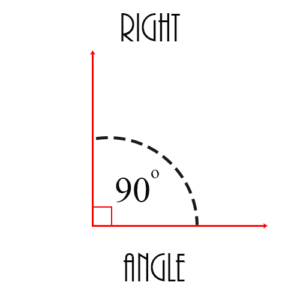
See also Acute, Obtuse, Vertical, Complementary, Supplementary Angles
Right Triangle: A triangle with one right angle.

See also Acute, Equilateral, Isosceles, Scalene, Obtuse, Similar, Congruent, Pythagorean Theorem, Hypotenuse, Legs
Scalene Triangle: A triangle with 3 unequal sides. The figure shows an acute triangle which is also scalene. An obtuse triangle can also be a scalene triangle.
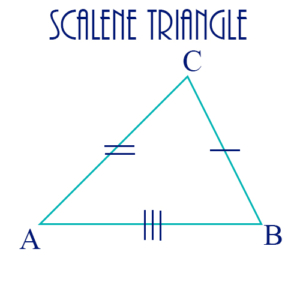
See also Acute, Right, Equilateral, Isosceles, Obtuse, Similar, Congruent
Scientific Notation: A representation of a decimal or integer as a value between 1 and 10, multiplied by a power of 10. Examples:
\(\begin{align}99999 = 9.9999 \times 10^4\end{align}\)
\(\begin{align}.099 = 9.9 \times 10^{-2}\end{align}\)
The exponent for 10 indicates the number of places the decimal point should be moved to the right or to the left. In the first example above, the exponent is 4, so to get the original number, you move the decimal point 4 places to the right. In the second example, the exponent is -2, so you move the decimal point 2 places to the left.
Secant: A line which passes through a circle, intersecting 2 points on the circle.
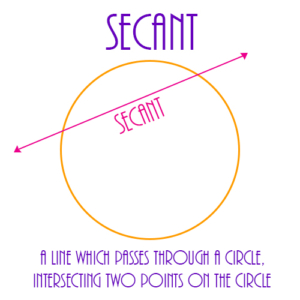
See also Radius, Diameter, Circumference, Tangent, Circles
Secant Function: A trigonometric function on angles. The secant’s value is the inverse of the cosine’s, and so is given by the formula:
\(\begin{align}\sec A = \frac{h}{a}\end{align}\)
where angle A is in a right triangle, a is the side adjacent to A, and h is the hypotenuse of the triangle.
See also Sine, Cosine, Tangent, Cosecant, Cotangent, Inverse Functions
Similar Triangles: Two triangles with corresponding angles equal to each other. Their corresponding sides are in the same ratio, but they aren’t necessarily equal.
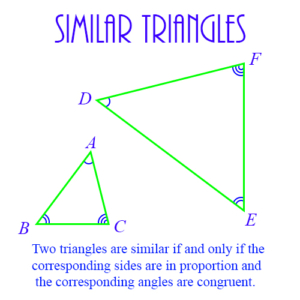
See also Acute, Right, Equilateral, Isosceles, Scalene, Obtuse, Congruent
Sine: A trigonometric function on angles. The sine’s value is given by the formula:
\(\begin{align}\sin A = \frac{o}{h}\end{align}\)
where angle A is in a right triangle, o is the side opposite A, and h is the hypotenuse of the triangle.
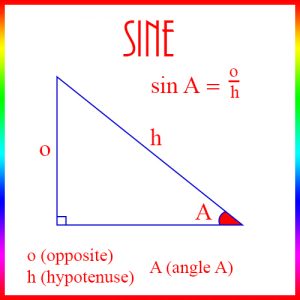
See also Cosine, Tangent, Secant, Cosecant, Cotangent, Inverse Functions
Slope: The rate at which a line is rising or falling. If a line’s slope is positive, then the line is rising as it moves from left to right. If the slope is negative, then the line is falling as it moves from left to right. A simple example is:
\(\begin{align}y = 3x\end{align}\)
This line increases its y value by 3 every time its x value increases by 1. Thus, if x = 0, then y = 0. If x = 1, y = 3, etc. We say in this case that the slope of the line is 3.
For an opposite example, consider:
\(\begin{align}y = -3x\end{align}\)
On this line if x = 0, then y = 0, but if x = 1, then y = -3. So every time x increases by 1, y decreases by 3. So the slope of this line is -3.
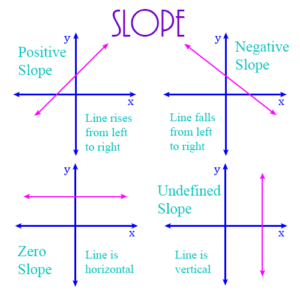
See also Coordinate Axes, Coordinates, Quadrants, Point, Line, Intercept
Special Triangles: These triangles occur frequently in problems because of their “natural” structure.
30-60-90: This triangle is one-half of an equilateral triangle. A line from the apex of an equilateral triangle to the midpoint of the base results in two congruent right triangles (see diagram). If each side of the equilateral triangle is of length 2, then the three sides of each half of the triangle have lengths as shown in the diagram.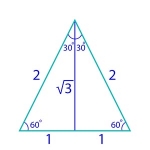
45-45-90: This triangle is an isosceles right triangle. If we assume that the legs of the triangle are each of length 1, then its 3 sides have lengths as shown in the diagram.
See also Acute, Right, Pythagorean Theorem, Legs, Hypotenuse, Equilateral, Isosceles, Scalene, Obtuse, Similar, Congruent
Sphere: A 3-dimensional figure consisting of a set of points, all of which are the same distance from a single, central point. The distance from the center point to any point on the sphere is the radius of the sphere. The figure shows a sphere of radius r, together with the formula for the surface area of the sphere.
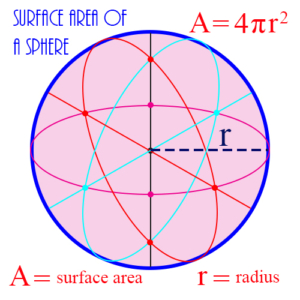
See also Prism, Cube, Cylinder, Cone, Pyramid, Circle
Square: A 4-sided figure with each side the same length and each angle a right angle.
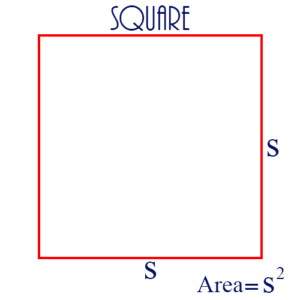
See also Rectangle, Trapezoid, Parallelogram, Right Angle
Supplementary Angles: Two angles whose sum is 180 degrees. In the figure angles 1 and 2 are supplementary, as are angles 1 and 4, 2 and 3, and 3 and 4.
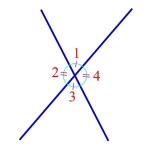
See also Acute, Right, Obtuse, Vertical, Complementary Angles
Tangent: A line which intersects or “touches on” a circle at exactly one point.
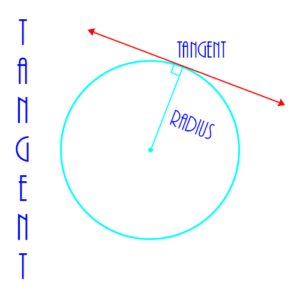
See also Radius, Diameter, Circumference, Secant, Circles
Tangent Function: A trigonometric function on angles. The tangent’s value is given by the formula:
\(\begin{align}\tan A = \frac{o}{a}\end{align}\)
where angle A is in a right triangle, o is the side opposite A, and a is the side adjacent to A.
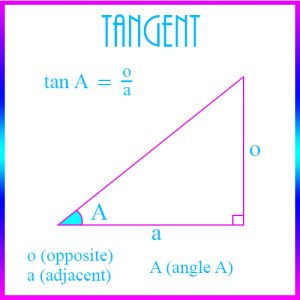
See also Sine, Cosine, Secant, Cosecant, Cotangent, Inverse Functions
Term: A single part of a polynomial, consisting of a variable raised to a power multiplied by a constant, or a single constant with no variable. Example:
\(\begin{align} 3x^2 + 5x – 9\end{align}\)
is a polynomial with three terms: \(\begin{align} 3x^2, 5x, -9\end{align}\)
See also Constant, Coefficient, Variable, Monomial, Product, Factorization
Transversal: A line which intersects two other lines. If the other two lines are parallel, then the transversal makes the same angle with both of them.
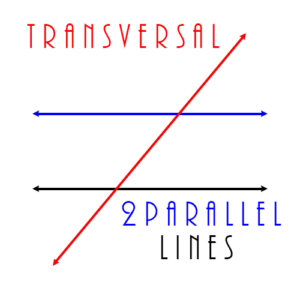
See also Parallel, Perpendicular, Tangent, Secant
Trapezoid: A 4-sided figure with two opposite sides parallel, but the other two opposite sides not parallel. The figure shows a trapezoid together with the formula for its area.
Variable: A symbol in a polynomial, usually a letter from the end of the alphabet like x, y, or z, which may represent any number from a set, usually the set of real numbers. Example: In the polynomial
\(\begin{align} 3x^2 + 5x – 9\end{align}\)
x is a variable.
See also Constant, Coefficient, Term, Monomial, Product, Factorization
Vertical Angles: Two angles, as angles 1 and 3 in the figure, which are on opposite sides of the intersection of 2 lines. 
They are always equal to each other, because they are both supplementary to the same angle. For example, in the figure, angles 1 and 3 are vertical angles and are equal because they’re both supplementary to angle 2. Angles 2 and 4 are also vertical angles and are equal.
See also Acute, Right, Obtuse, Complementary, Supplementary Angles

